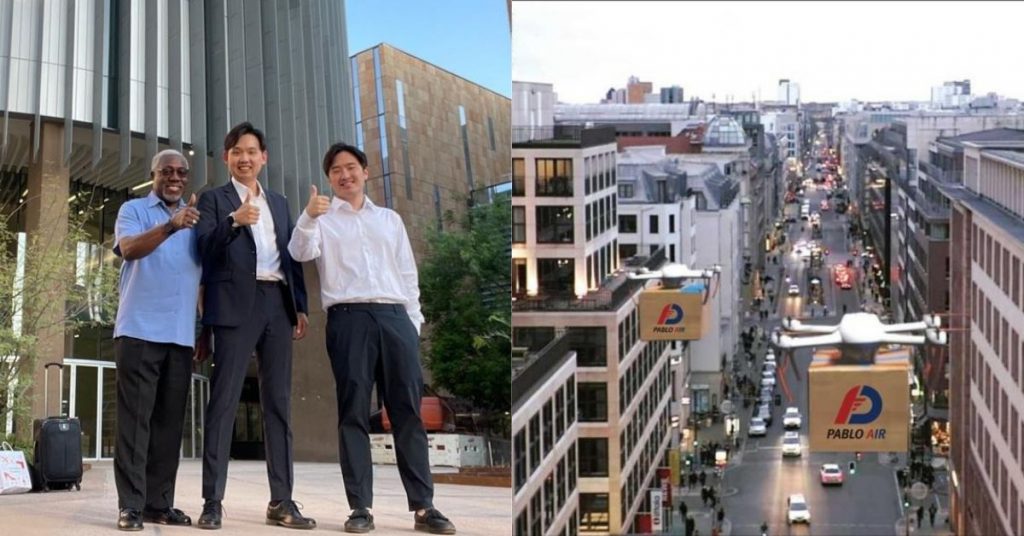[Written in partnership with MaGIC, but the editorial team had full control over the content.]
Malaysia’s dronetech scene is no doubt an interesting industry to keep one’s eyes on, but it’s only in recent years that we’ve seen more substantial support for the sector.
For now, drones are largely still being used for agriculture and security/monitoring purposes in Malaysia. On the horizon, however, could be drone deliveries, following AirAsia’s pilot tests in Cyberjaya back in March 2021.
Eyeing this scene is also South Korean company PABLO AIR, which offers drone logistics solutions and delivery services. It’s a part of the current Global Accelerator Programme (GAP) held by the Malaysian Global Innovation & Creativity Centre (MaGIC), but more on this later.
We spoke to PABLO AIR team lead, Derek Lee, to learn more about what their GAP involvement means for the company and for Malaysia’s dronetech industry.
Been there, done that
Launched in 2018, PABLO AIR already has a few notable drone delivery achievements under its belt. In December 2020, it made the news after its drones carried out a 50-mile (about 80.6km) journey from Incheon New Port to two islands, Yeonghuengdo Island and Jawoldo Island.
The journey took 1 hour and 20 minutes and marked the longest drone flight made in Korea thus far. With it, emergency medicines and everyday items were successfully flown over.

Prior to this, PABLO AIR had also carried out a 35.7-mile (about 57.5km) journey from Jejudo’s Seogwipo Port to Udo Port in 1 hour and 56 minutes.
“Thanks to these successful demonstrations, we are launching the actual drone delivery services [for the] delivery of products in convenience stores and medical supplies in Q1 2022,” Derek said.
The company also secured US$8 million in a pre-Series B round in July 2021, and announced that the funds would go towards global expansion.
This means a potential expansion to Malaysia as well, which is one of the reasons why PABLO AIR joined GAP as part of Cohort 5.
Finding the right local partners
Each country has its own set of regulations regarding unmanned aerial vehicles (UAVs) such as drones. In Korea, PABLO AIR credited related government bodies for their support and assistance in making the drone delivery demonstrations work.
But as it expands, it will have to find similar support from foreign governments. “Since it includes aviation regulation and law, it is highly restrictive and provides limited access to a foreign company,” Derek added.
“To overcome this challenge, we are now approaching government authorities and corporate partners who can assist us in conducting proof of concept (POC) in Malaysia.”
This is where MaGIC’s GAP comes in to help the company build its market strategy and expand its partners in Malaysia. An example of what PABLO AIR has been able to benefit from is knowledge about the National Technology and Innovation Sandbox (NTIS), which it is now in discussion with for future collaborations.
While that solves one challenge for the startup, there is something else to consider too: the localisation of its solution.
“For example, some countries might value our technology and service for medical supplies but the other countries might be more interested in small package delivery from a restaurant, or a logistics company who would like to replace their supply chain amount with our drone service,” Derek said.
“As our solution is ultimately serving both corporations and customers (end-users), we need to aggressively adapt our business model and solution into a different country with different needs.”
Collaborating to commercialise dronetech
Following an expansion to Malaysia, Derek shared what PABLO AIR could contribute to our local dronetech industry.
“As we were the first generation of drone startups in South Korea, we know [what] the Korean regulatory authorities have done to promote the industry, removing regulatory obstacles gradually.”
“For example, if you would like to operate drones Beyond Visual Line of Sight (BVLOS), there are many different considerations implemented to approve the operation,” he said.
Dictionary Time: BVLOS is a term relating to the operation of UAVs and drones at distances outside the normal visible range of the pilot (500m). BVLOS drone operations provide numerous advantages over regular line-of-sight flying, and are more cost-effective.
Unmanned Systems Technology / Geospatial World
With PABLO AIR’s experience and knowledge, Derek said they’d be honoured to work together with Malaysian regulators to shape policies.
In order to push for the commercialisation of dronetech in Malaysia, collaboration will be crucial, and PABLO AIR’s demonstrations will be useful case studies to develop our industry further.
Being that it’s still an untapped market too, there will be plenty of opportunities and benefits for local and international drone companies alike to reap.
Also Read: Alibaba Cloud was a star player behind the scenes in this year’s Tokyo Olympics, here’s how
Featured Image Credit: PABLO AIR










